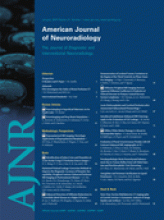We read with great interest the article by Uemura et al,1 who reported a case of successful percutaneous sacroplasty for a hemorrhagic metastasis from hepatocellular carcinoma (HCC). They used a combination of bone cement and n-butyl 2-cyanoacrylate in the procedure, obtaining persistent pain relief and reduction of tumor volume. We believe that the use of this procedure will increase in time in patients with HCC metastatic to the spine.
Vertebroplasty is sometimes complicated by cement embolism,2 and the patients undergoing the procedure for spine metastasis from HCC can be no exception. In general, cement embolism can be easily diagnosed with either radiography or CT.3 However, from our recent experience, we think that such a radiologic appearance may not be specific to cement embolism in patients with HCC who have a history of hepatic resection and transarterial chemoembolization (TAE). We report our case of iodized oil (Lipiodol; Andre Guerbet, Aulnay-sous-Bois, France) embolism bearing a striking resemblance to cement embolism.
A 58-year-old man was admitted for TAE. He had undergone the procedure regularly since he was diagnosed with postsurgical recurrence of HCC. Due to a complete obstruction of the right proper hepatic artery from a prior procedure, TAE was performed via the right internal thoracic artery by using a microcatheter, through which a mixture of Lipiodol and polyvinyl alcohol (500–700 μm, Contour; Boston Scientific, Natick, Massachusetts) was injected. At the time of the injection, opacification of the pulmonary arteries was observed in the right lower lung zone (Fig 1). Lipiodol opacified the distal portion of an arterial branch first, accumulating centripetally toward the top of the branch where it quickly embolized to the distal end of another branch. The patient was asymptomatic throughout the procedure. Noncontrast CT showed high-attenuation linear branching opacities in the right lower lobe, representing a Lipiodol cast in the pulmonary arteries (Fig 2).
A 58-year-old man with postsurgical recurrence of hepatocellular carcinoma. Selective right internal angiogram, obtained during the injection of Lipiodol and polyvinyl alcohol mixture, shows opacification of pulmonary artery branches in the right lower lung zone.
A 58-year-old man with postsurgical recurrence of hepatocellular carcinoma. Noncontrast posttransarterial chemoembolization CT shows high-attenuation linear branching opacities in the right lower lobe, representing Lipiodol cast in the pulmonary artery branches.
Radiologic findings of Lipiodol embolism observed in this patient were different from those described in the literature: In general, it appears as diffuse bilateral pulmonary parenchymal infiltrates.3 At that time, we suspected that this case was different probably because Lipiodol was embolized not via the inferior vena cava and then the right heart but via transdiaphragmatic collaterals.
Later, we experienced another case showing such a transphrenic communication and subsequent Lipiodol embolism, which was unilateral. In that case, the patient was a 62-year-old man and, as in the current patient, had a history of prior hepatic resection (Fig 3). Post-TAE CT showed high-attenuation consolidations typical for a Lipiodol embolism, which were exclusively in the right lung. We postulate that previous hepatic resection and the formation of adhesions between the tissues were responsible for such an abnormal communication between the systemic and pulmonary vasculature, resulting in either high-attenuation linear branching opacities or high-attenuation consolidation, depending on the degree of tissue reaction.
A 62-year-old man with postsurgical recurrence of hepatocellular carcinoma. A selective right inferior phrenic angiogram shows opacification of the pericardiacophrenic artery (arrows).
A history of prior hepatic resection, postsurgical TAE, and spinal metastasis all represent an advanced stage of HCC, and these 3 conditions can potentially coexist in a candidate for vertebroplasty. Therefore, we propose that noncontrast CT should be performed before vertebroplasty of such a patient for screening of Lipiodol embolism.
In conclusion, in patients undergoing vertebroplasty due to metastasizing HCC, Lipiodol embolism may appear as high-attenuation branching linear pulmonary opacities simulating cement embolism from vertebroplasty.
- Copyright © American Society of Neuroradiology















